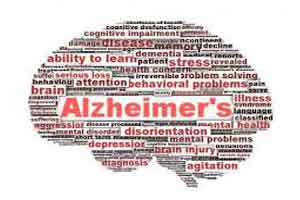- Home
- Editorial
- News
- Practice Guidelines
- Anesthesiology Guidelines
- Cancer Guidelines
- Cardiac Sciences Guidelines
- Critical Care Guidelines
- Dentistry Guidelines
- Dermatology Guidelines
- Diabetes and Endo Guidelines
- Diagnostics Guidelines
- ENT Guidelines
- Featured Practice Guidelines
- Gastroenterology Guidelines
- Geriatrics Guidelines
- Medicine Guidelines
- Nephrology Guidelines
- Neurosciences Guidelines
- Obs and Gynae Guidelines
- Ophthalmology Guidelines
- Orthopaedics Guidelines
- Paediatrics Guidelines
- Psychiatry Guidelines
- Pulmonology Guidelines
- Radiology Guidelines
- Surgery Guidelines
- Urology Guidelines
Hope for Alzheimers cure as scientists develop protein

Washington D.C : A newly developed protein, which will help scientists to understand why nerve cells die in people with Alzheimer's disease, could pave way for new treatment strategies.
In Alzheimer's patients, Amyloid-beta (Abeta) proteins stick together to make amyloid fibrils that form clumps between neurons in the brain. It's believed that the build-up of these clumps causes brain cells to die, leading to the cognitive decline in patients suffering from the disease.
It is not known why this particular protein's "stickiness" causes cells to die and scientists have been unable to properly test whether the sticky clumps of Abeta proteins have different effects, compared with individual proteins that are not stuck together.
Now, University of Sussex scientists have created a new protein, which closely resembles the Abeta protein in size and shape, but contains two different amino acids (the building blocks that proteins are made up of).
These changes mean that the new protein does not form amyloid fibres or sticky clumps, and, unlike Abeta, is not toxic to nerve cells, according to the study.
Lead author Karen Marshall said: "Understanding how the brain protein Abeta causes nerve cell death in Alzheimer's patients is key if we are to find a cure for this disease. Our study clearly shows that the aggregation of Abeta into bigger species is critical in its ability to kill cells. Stopping the protein aggregating in people with Alzheimer's could slow down the progression symptoms of the disease. We hope to work towards finding a strategy to do this in the lab and reverse the damaging effects of toxic Abeta."
Senior author Louise Serpell said: "This is a really exciting new tool that will contribute to research to uncover the causes for Alzheimer's disease and enable tangible progress to be made towards finding targets for therapy."
The study is published in journal Scientific Reports.

Disclaimer: This site is primarily intended for healthcare professionals. Any content/information on this website does not replace the advice of medical and/or health professionals and should not be construed as medical/diagnostic advice/endorsement or prescription. Use of this site is subject to our terms of use, privacy policy, advertisement policy. © 2020 Minerva Medical Treatment Pvt Ltd